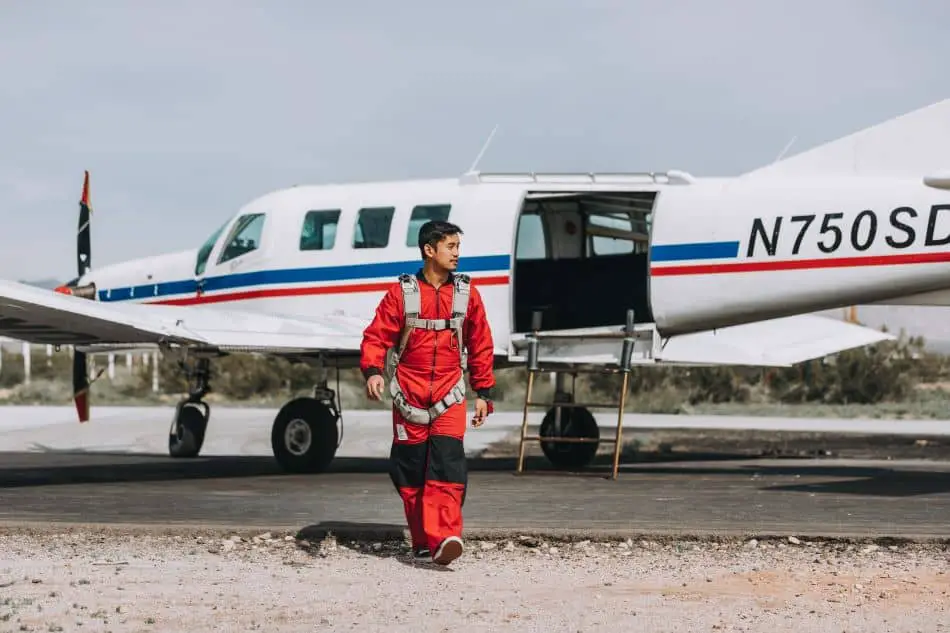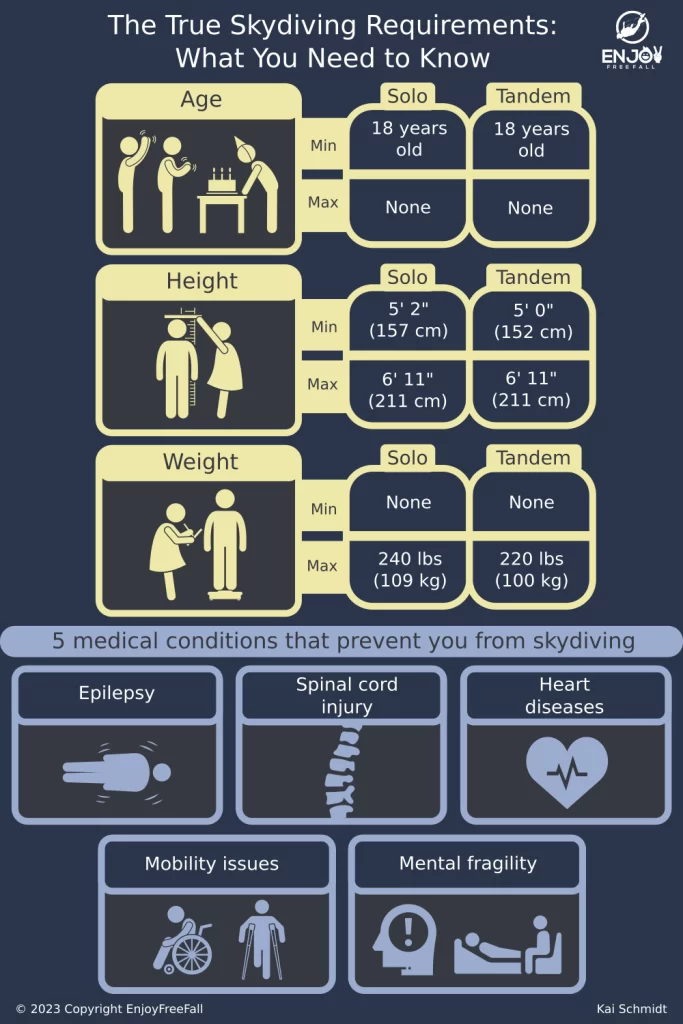
Deciding whether to take your first jump or not can be stressful. However, not meeting the skydiving requirements and being refused to skydive on your jump day is even more stressful and frustrating. To avoid this, I have summarized the true requirements for skydiving.
To go on a solo or tandem skydiving jump, you must be at least 18 years old, weigh below 220 lbs, and have a height of between 5-6 ft. It is also important to declare any pre-existing medical conditions during the on-site assessment.
| Basic Requirements | Solo Skydiving | Tandem Skydiving |
| Minimum Age | 18 years old | 18 years old |
| Maximum Age | None | None |
| Maximum Weight | 240 lbs (109kg) | 220 lbs (100kg) |
| Minimum Height | 5′ 2″ | 5 feet |
| Maximum Height | 6’11” | 6’11” |
How Old Does One Need to Be to Skydive?
Most skydiving centers in the US are members of the United States Parachute Association (USPA) which regulates skydiving companies together with the Federal Aviation Authority (FAA). The USPA and FAA released the Basic Safety Requirements (BSRs) that skydiving companies have to comply with. As part of these requirements, the minimum age is set at 18 years old for both solo and tandem skydiving.
Initially, the minimum age to skydive was 16 years old as long as the teenager can provide parental consent. However, after a 16-year-old girl was severely injured in a skydiving accident in 2014, the USPA increased the age limit across the US to 18 years old.
It also increased the number of jumps that need to be performed before receiving the solo skydiving license to 25. (There are still a few skydiving companies that allow for skydivers below 16 years old – however, then they are not members of the USPA)
If you want to learn more about skydiving licenses, make sure to read my guide about how to get a skydiving certificate. It covers the whole licensing process and reveals easy and practical tips to excel at the license!
In contrast to minimum age, skydiving does not have a maximum age limit. As long as someone is in good health and can lift his legs, he/she is allowed to jump – even if older than 100 years.
For older people, it is advisable to get medical clearance from a doctor beforehand. Doctors know the risks and health requirements for skydiving and can educate their clients about it. If someone wants more specialized advice, some doctors skydive as a hobby.
On 15 August 2019, Kathryn “Kitty” Hodges from Washington became the oldest woman to complete a tandem skydive according to the Guinness World Records. Born in April 1916, Kitty was 103 years and 129 days old when she made the jump from 10,000 ft over Snohomish County.
Kitty had decided to skydive for the first time because her oldest son jumped regularly and convinced her to try it out as well. Kitty was accompanied by her two sons and her granddaughter and arrived safely at the dropzone.
Did you know that there are also world records for the highest skydiving jumps? If not, make sure to check out my article about true skydiving heights including the world’s highest and most incredible skydives ever performed. You will be stunned by how extreme athletes have pushed the boundaries of skydiving!
Are There Weight Limits in Skydiving?
Most skydiving centers in the US are strict with their weight limits. The limit is 240 lbs for solo skydiving and 220 lbs for tandem skydiving including clothing and shoes. However, some centers can accommodate customers up to 275 lbs for tandem skydiving but it will be based on availability. If you are overweight, you will need to inform the skydiving company ahead of time so that they can prepare the necessary skydiving equipment.
If you’re wondering why there’s a weight limit in skydiving, delve into my dedicated article that unravels the mysteries behind the weight limit and explores its crucial role in skydiving. Discover the reasons why the weight limit should never be overlooked and gain a deeper understanding of its significance in your skydiving journey.
If you are unable to meet the weight requirements, you can use skydiving as a health goal. I know a few people who took skydiving as a challenge and inspiration to lose extra pounds until they were light enough and met the weight requirements.
On the 26th February 2010, Gary Holm, who weighed around 380 lbs (172 kg) decided to achieve his lifelong dream of skydiving. Since he exceeded the skydiving weight limits that ensure safety, he needed to lose weight to fulfill his dream.
He started eating healthy and exercised at least 2-3 times a day. He also created his blog (“The Flying Fat Guy”) to track his journey and to stay motivated over time. He found many supporters that motivated him to continue even if he was in despair.
In a year, Gary lost a total of 180 lbs (82 kg) and brought down his weight to 200 lbs (91 kg). On his 33rd birthday, he went to Las Vegas together with his friends to celebrate his success and to prepare for the jump.
It was so inspirational that the CBS “The Early Show” co-host Jeff Glor joined him on his big day. Gary and Jeff jumped from a 15,000 ft height together and achieved a speed of 100 mph during their free fall.
It was a year-long weight loss journey for Gary that led him in fulfilling his lifelong dream of jumping from an airplane.
Are There Height Limits in Skydiving?
During skydiving, your weight should be proportional to your height. You should be between 5’2” to 6’11” ft tall for solo jumps and between 5 ft to 6’11” ft for tandem jumps.
Being too short or too tall might be challenging for skydiving. Especially if you will be accompanied by a tandem instructor. After the on-site assessment, you will be assigned a tandem pair based on your weight and height profile. This is to make sure that the skydiving equipment and your instructor will be able to safely support you during the jump.
Being taller than the instructor can be problematic specifically during the freefall and landing. During the freefall, the tandem instructor needs to counterbalance the student and bring him in an arch position which will be significantly harder if the student is taller than the instructor.
During landing, tandem students need to lift their feet in front of themselves and point their toes toward the sky. If students are taller than the instructor, it is more difficult for the tandem instructor to reach the ground with his feet earlier and to absorb the impact of the landing. Being unable to do so might result in accidents and injuries.
That said, be sure to check out my skydiving 101: everything you need to know about your tandem landing. In this post, I explain everything you need to know about the landing including what mistakes you should avoid as a tandem student to ensure a safe landing!

Is There a Physical Fitness Requirement to Skydive?
To skydive, you just need to meet minimal requirements such as the age, weight, and height limits set by the skydive center. Your tandem instructor will also give you several instructions that you need to follow inside the airplane, during the free fall and landing preparation such as bend, kneel, perform a body arch position and lift your legs then you are good to go.
Being athletic or having strong arms, legs, or core strength would be a great advantage but you will also develop those as you continue practicing your jump. Any pre-existing medical condition should have a green light from your doctor and be declared during the on-site assessment.
Did you know that skydiving offers far more than just physical exercise? Prepare to be amazed as my article “is skydiving a good workout” delves into the lesser-known advantages that lie beyond the adrenaline rush. Explore the emotional and mental benefits that, in my opinion, surpass the physical gains.
Pre-Existing Medical Conditions That Are Allowed for Skydiving
Before skydiving, it is important to declare any pre-existing medical condition such that the skydive center can assess the safety of the jump. You can do it by contacting the skydiving center beforehand or by bringing a health certificate from your doctor.
Medical conditions like high vital sign or diabetes require careful consideration. Having these conditions doesn’t necessarily stop you from skydiving. After all, many folks with high vital signs or diabetes still skydive but it should be managed and controlled.
Whether people are allowed to skydive with pre-existing conditions can be decided on a case by case basis.
There are also people with multiple amputees and disabilities who skydive. For example, Jarrett Martin is a paraplegic skydiver who skydives despite being paralyzed from the chest downward. He started skydiving at the age of 9 together with his father and started to jump independently at 15 (He performed private jumps where the age requirements of the USPA do not apply to).
Unfortunately, he was 18 when he had a parachuting accident in Hawaii. He became paralyzed from the chest down but it didn’t stop him from skydiving. After six months, he started jumping from an airplane again.
After the accident, Jarrett moved to Florida to become a master parachute rigger. He also competed in Dubai for an accurate skydive event under the US Team. A skydiving company in Dubai was so impressed by his story that they offered him a full-time job. Jarrett has moved to Dubai permanently where he’s just one of just two qualified master parachute riggers.
5 Medical Conditions That Prevent You From Skydiving
Unfortunately, some medical conditions that may stop you from participating in skydiving events. If you have any pre-medical conditions, the first thing that you need to do is to contact your doctor and get clearance from him. Your doctor knows your health situation best and can give good advice.
If he is not sure, because he does not know the effects of skydiving on your body, he can pass you on to a specialist. On top, skydiving centers will assess your physical conditions before the jump and they might reject you if they think you are not healthy enough.
If you have the following, you should definitely talk to your doctor before skydiving:
Epilepsy – Some skydivers have epilepsy and continue to skydive despite the risk of a seizure. One way is to perform a tandem jump. Having a seizure during a tandem jump is still dangerous because it will be much harder for the tandem instructor to counterbalance the movements and ensure stability during the freefall and canopy ride. While it is comparably safe to perform a tandem jump, solo skydiving is much riskier.
For example, Christopher Jones from Western Australia jumped from an altitude of 12,000 ft, suddenly fell unconscious, and suffered seizure mid-air at around 9,000 ft. He was rescued by his skydiving instructor, Sheldon Mcfarlane who caught up with him at 4,000 ft and successfully deployed his main parachute.
Mental Conditions – These can be very hard to spot especially because people will often not talk about their mental state. There is a broad range of mental conditions that should prevent people from jumping. Again it would be best to consult the doctor beforehand.
For example, people with ADHD can still jump if they get help and are accompanied by a trained instructor. People with more severe conditions are not recommended to jump due to safety constraints.
Heart Conditions – Skydiving is an extreme sport. You will jump from an airplane at around 10,000 ft and freefall at a speed of 120 mph. An extreme sport is not ideal for people with severe high blood pressure or pacemaker since it is an adrenaline-pumping activity and involves a lot of risks.
Mobility Issues – If you are suffering from a recently dislocated shoulder/arm or leg injury it will be best to reschedule your skydiving plans. Skydiving requires people to be flexible and to stabilize themselves during freefalling as well as landing. People also need to control the parachute and steer it towards the dropzone, which can be quite exhausting. Injuries that restrict someone from these movements are dangerous.
Spinal Cord Injury – People with a severe bad back or spinal cord injuries are not recommended to jump. If anything goes wrong and they have a high impact landing, it might result in more serious injuries.
If you want to know more about the 11 incredible effects that skydiving has on the human body, check out this post for more information.
What to Bring to the Jump?
To make sure that everything will go smoothly during the day of your skydive, here is a list of the things that you need to bring.
- A valid photo ID – Any government-issued ID such as driver’s license, state ID, or passport will do (proving that you are at least 18 years old). You will not be allowed to jump without a valid photo ID.
- Payment – Most skydiving centers accept cash and credit card. However, they do not accept checks and just to be certain, ask your dropzone what they do or do not accept. It is also recommended to bring extra money, in case you decide to add a skydiving photo and video package.
- Proper clothing – During summer, it is best to wear a t-shirt, jogging pants or leggings plus your favorite tennis shoes. But if it is too cold, consider wearing a long sleeve shirt or thin layers. Do not wear any clothing that has zippers, strings, or holes. Pieces of jewelry, slippers, high heels, and boots are also not allowed. To learn more information about the five things to wear and not to wear while skydiving, you can check this post.
- Eyeglasses or contacts – If you are wearing prescription eyeglasses or contacts do not forget to bring them. Just make sure to inform your tandem instructor so that they give you the right goggles that ensure a secured and snug fit.
- Facemask, neck gaiter, neckerchief, or bandana – Since Covid-19, skydiving centers have implemented strict health guidelines to secure the safety of their jumpers. Wearing a facemask, neck gaiter, neckerchief, bandana, or full-face helmet is required inside the plane.
- Extra clothing – You need to expect that your clothing or shoes will get dirty during skydiving. Especially if you happen to land on a grassy, soft, or muddy area of the dropzone.
- Snacks and drinks – Waiting for your time to jump can take a while – sometimes as much as 2.5 to 3.5 hours during weekdays and 3.5 to 5 hours during weekends. So it will be nice to have some food and drinks with you. If you are not able to eat properly due to excitement, it would be best to pack a light snack and drinks in case you will need them. It is also important to stay hydrated before a skydive.
- Family members and friends – tagging along a few family members and friends will help you since they can be your cheerer and support system on the ground. Since most skydiving also has picnic areas, you can spend some quality time with them while watching other skydivers. If your friends and family don’t have time to witness your first skydive, make sure to get a video of your jump. A skydiving video can preserve this life-changing moment, which you can share with your family and friends afterward. If you are unsure if the extra money is worth the video, make sure to read my article about the 5 reasons why skydiving videos are worth it. The article includes the surprising reasons why you won’t regret spending more money to get a video!
House Rules When Skydiving
Just like any sport, skydiving has some house rules which may differ from skydiving company to skydiving company. Here are the essential rules that you simply got to know before your first jump.
- Smoking – Smoking isn’t permitted while wearing skydiving equipment or within the parachute packing center.
- No alcohol or stimulants before the jump – Consumption of alcohol or other stimulants on the day before the jump is prohibited. Persons under the influence of alcohol won’t be allowed to participate in any skydiving program.
- Guests aren’t allowed to pass the barriers – Guests aren’t allowed to travel over the barrier or white fence of an active airfield. There are picnic areas specifically assigned for guests and spectators.
- Children got to be under direct adult supervision while inside the dropzone – If you bring your children with you, they must be accompanied all the time. Bringing snacks, games, and activities while they wait is advisable.
- Designated parking – Vehicles should be parked properly to the designated parking or sometimes labeled as “Visitors Car Park”.
- Follow airport rules – This applies if the skydiving center is inside an airport facility.
- Dogs and Cats – If you plan to bring your fur babies, it would be best to contact your skydive center to check if it is allowed.
In conclusion, most people meet the requirements to skydive. The only thing that should limit yourself is if you have any pre-existing medical conditions and your doctor does not advise skydiving.
If you believe that you are too old – you are not! Age is just a number in skydiving and there have been older people that jumped. Skydiving may not be for everyone but if everyone should try it out. After all, it might become your new passion.
Enjoy your first freefall!




